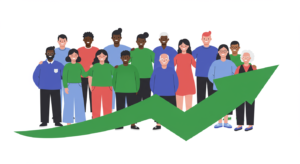
Let’s Stop Pretending Mental Health Is Separate From Inclusion
If you’re still treating mental health as a “personal issue” or a benefit buried in HR paperwork, you’re already behind.
Mental health impacts who feels safe, who stays silent, who thrives—and who leaves. And that impact is never neutral. It’s shaped by identity, access, leadership, and the systems we work in every day.
Here are 5 powerful data points to prove the connection—and what to do with them as a practitioner, leader, or advocate.
1. 1 in 5 U.S. adults experience mental illness each year
Source: National Alliance on Mental Illness (NAMI)
This isn’t a niche issue—it’s reality for 20% of your workforce.
What to do with it:
- Normalize mental health as a regular topic, not a special initiative
- Add mental health check-ins to team rhythms: “What’s your current bandwidth—emotionally and mentally?”
2. Only 47.2% of U.S. adults with mental illness receive treatment
Source: Substance Abuse and Mental Health Services Administration (SAMHSA)
Access gaps persist—especially across marginalized communities.
What to do with it:
- Audit your org’s wellness benefits: Are they accessible, inclusive, and visible?
- Ensure mental health resources are listed in onboarding and ERG materials
3. 74% of employees with mental health conditions don’t disclose to HR
Source: Mind Share Partners
People don’t speak up—because they don’t trust the system.
What to do with it:
- Train managers to respond to vulnerability with care, not concern-trolling
- Shift culture from “mental health awareness” to “mental health safety”
4. 52% of employees report feeling burned out
Source: Future Workplace and Blueboard
Burnout isn’t about effort. It’s about systems that push people to their edge.
What to do with it:
- Review workloads and expectations through an equity lens
- Create space: async days, no-meeting zones, rest as part of team norms
5. Only 31% of employees say their company’s culture supports mental well-being
Source: American Psychological Association (APA)
That’s not a people problem—it’s a leadership and design problem.
What to do with it:
- Redefine what a “high-performing” culture means
- Embed mental well-being into performance conversations, not just crisis response
Mental Health Belongs in Every DEI Conversation
These numbers don’t lie—and they don’t just point to a wellness gap. They highlight where inclusion breaks down.
If we’re not supporting mental health, we’re not building equity. Full stop.
Want tools to turn these stats into action?
Join the Diversiology Community for weekly implementation ideas, community support, and real talk from people doing the work.








